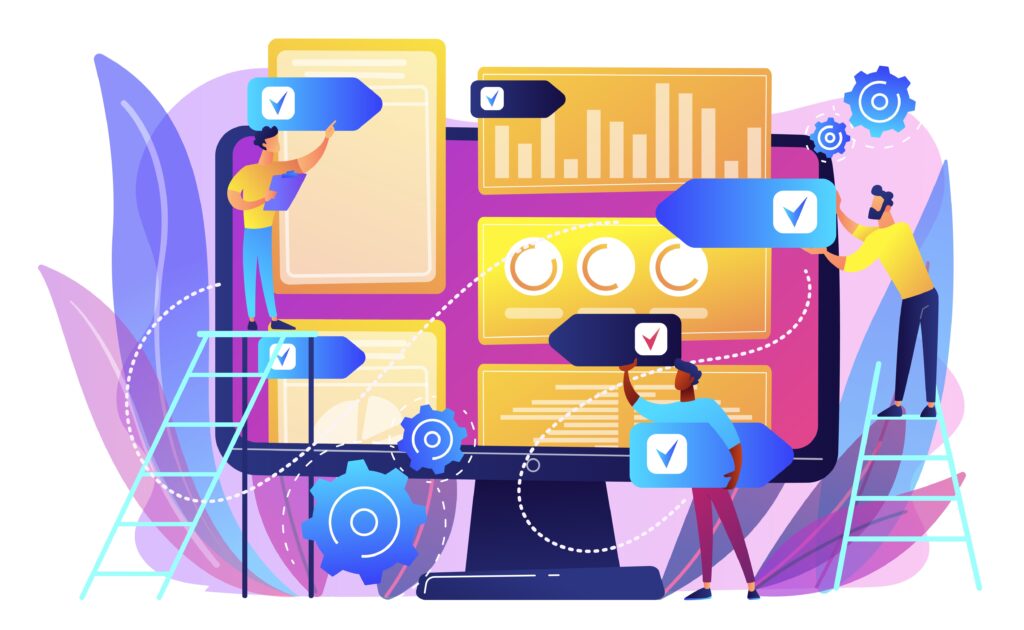So yes, businesses are constantly seeking ways to streamline their operations and enhance the customer experience. One term that has gained significant prominence in the world of ecommerce is “omnichannel.” Businesses are constantly seeking ways to streamline their operations, improve efficiency, and enhance the customer experience. One of the most transformative strategies to achieve these goals is omnichannel commerce. If you’re running a business and want to stay ahead of the competition, embracing omnichannel software can be a game-changer.
This guide delves into the world of omnichannel software, exploring its meaning, significance, and how it can revolutionize your business.
Understanding Omnichannel Commerce
Before we dive into the specifics of omnichannel software, it’s important to understand the concept of omnichannel commerce itself. In the past, businesses operated with distinct, isolated sales channels. Customers may have interacted with your brand in one of these channels—such as in-store, through a catalog, or via a website—and the experience across these channels was often fragmented.
Omnichannel commerce is an approach that integrates all these channels to create a unified experience for the customer. The goal is to break down barriers between the channels, so whether a customer interacts with your brand in-store, on your website, via a mobile app, or through social media, they receive a seamless and consistent experience.
In simpler terms, omnichannel commerce acknowledges that the consumer’s journey is no longer linear. A customer might browse products on their phone, check them out in-store, and then make the final purchase online. They may interact with your brand on social media, receive recommendations via email, and even access customer service through a chatbot. The customer expects all of these experiences to be connected, which is where omnichannel software comes in.
How Omnichannel Commerce Differs from Other Commerce Models
When it comes to retail strategies, there are notable differences between omnichannel and other ecommerce business models, particularly multichannel commerce. These distinctions impact how businesses utilize retail software to streamline their operations and cater to customer needs effectively.
Omnichannel vs. Multichannel Commerce
The key difference between omnichannel and multichannel commerce lies in the focus of each strategy. Multichannel commerce tends to be product-centric. Retailers using a multichannel model offer their products across various sales channels—like their own e-commerce platforms, third-party marketplaces, social media storefronts, and offline in physical stores, pop-ups, or concessions. However, these channels often operate in isolation from one another. Each channel functions independently, without a unified system connecting them, meaning customers’ experiences are fragmented and inconsistent.
On the other hand, omnichannel commerce is customer-centric. It integrates both digital and physical channels into one unified experience. With omnichannel commerce, customers can engage with your brand in a seamless manner—whether they’re shopping in-store, on your website, or on social media. This model supports features like click-and-collect (buy online, pick up in-store), online inventory look-up, and order history synchronization across all touchpoints. The focus is on delivering a consistent experience, making sure that customers get exactly what they need when and where they need it, regardless of the platform they choose to interact with.
While many businesses begin with a multichannel strategy, the growing importance of a seamless customer experience leads many to evolve toward omnichannel solutions, which foster better connectivity between various sales and communication channels.
What is Omnichannel Commerce Software?
Omnichannel software refers to the suite of tools and technologies that enable businesses to manage and integrate their various sales channels into a cohesive and fluid experience for both customers and staff. These tools allow businesses to maintain consistency across all platforms, whether physical or digital. Essentially, omnichannel software serves as the backbone of omnichannel commerce, ensuring smooth and efficient operations across all touchpoints.
Key Components of Omnichannel Software
Omnichannel software isn’t just a single tool but a set of functionalities designed to streamline different aspects of the business. Let’s break down some of the core features and components of a typical omnichannel software platform:
1. Centralized Inventory Management
A core feature of omnichannel software is centralized inventory management. This feature allows businesses to track their products across all sales channels—physical stores, warehouses, online stores, and more— in real time. This provides a single view of stock levels, which helps avoid issues like overselling or stock discrepancies.
For example, imagine a customer places an order online, but the product is out of stock at the warehouse. The omnichannel system can automatically route the order to the nearest store that has the item, ensuring that the customer’s order is fulfilled as quickly as possible.
2. Unified Customer Profiles
Omnichannel software aggregates customer data from various touchpoints to create a unified customer profile. This means that businesses can capture information such as purchase history, browsing behavior, preferences, and even social media interactions, all in one place. By analyzing this data, businesses can gain a comprehensive understanding of each customer and use it to personalize their interactions.
For instance, if a customer has previously bought athletic shoes from your online store, you can use this data to recommend similar products like sports apparel or accessories. This level of personalization builds customer trust and enhances their shopping experience.
3. Seamless Order Fulfillment
Efficient order fulfillment is one of the cornerstones of omnichannel commerce, and omnichannel software plays a crucial role in streamlining this process. By automating order routing, businesses can ensure that customer orders are fulfilled quickly and cost-effectively. The software will analyze inventory levels across different locations and route the order to the most appropriate fulfillment center, whether it’s a warehouse or a nearby store.
Moreover, omnichannel solutions support flexible fulfillment options such as Buy Online, Pick Up In-Store (BOPIS) or Ship-from-Store. These choices allow customers to select the most convenient way to receive their purchases, improving satisfaction and reducing delivery times.
4. Integrated Marketing and Analytics
Another important feature of omnichannel software is its integration with marketing and analytics tools. These tools enable businesses to analyze customer behavior and campaign performance across all channels. With robust reporting and predictive analytics capabilities, businesses can track the effectiveness of their marketing efforts, identify trends, and make data-driven decisions.
For instance, if a particular marketing campaign is driving more traffic to your physical stores than your website, you can adjust your strategy accordingly. Analytics help businesses understand where to allocate resources to maximize ROI and refine their omnichannel strategies.
Why Do Omnichannel Solutions Matter?
Omnichannel solutions are not just trendy buzzwords—they’re crucial to meeting the evolving needs of consumers and staying competitive in the modern marketplace. Here’s why omnichannel software is essential for businesses of all sizes:
1. Enhanced Customer Experience
At the heart of omnichannel software is a commitment to delivering an exceptional customer experience. By connecting all your sales channels and offering personalized interactions, businesses can ensure that customers enjoy a smooth, consistent experience wherever they engage with your brand.
When customers interact with your business in one channel, they expect the same level of service and personalization in the next. If a customer adds a product to their cart on your mobile app, they want to be able to pick up that cart on your website or in-store without losing any progress. Omnichannel software ensures this continuity, increasing customer satisfaction and trust.
2. Increased Sales and Revenue
A seamless, integrated shopping experience encourages customers to spend more. When customers can easily find products, check real-time stock availability, and receive personalized recommendations, they’re more likely to follow through with a purchase.
By offering a range of flexible purchase options—such as BOPIS, buy online and return in-store, or ship-from-store—you provide customers with more choices, increasing the likelihood that they will make a purchase. Studies have shown that omnichannel customers tend to spend more than single-channel shoppers because they have access to a wider array of shopping options.
3. Improved Operational Efficiency
Omnichannel software streamlines many of the operational processes that businesses rely on, such as inventory management and order fulfillment. With a centralized system, businesses can reduce the time and effort spent managing separate platforms for each channel. This frees up valuable resources, allowing your staff to focus on higher-value tasks like improving customer service and developing marketing strategies.
Additionally, omnichannel systems automate many routine processes. For example, when an order is placed, the software can automatically select the most efficient fulfillment method, ensuring timely delivery with minimal manual intervention.
4. Data-Driven Decision-Making
Omnichannel software provides businesses with a wealth of data that can be used to make smarter, more informed decisions. With integrated analytics, businesses can track everything from product performance across different channels to customer purchasing behavior. This data can be used to optimize marketing strategies, inventory management, and even store layouts.
For example, if a specific product sells better in one region or during a particular season, businesses can adjust their inventory and marketing efforts to capitalize on these insights.
Key Features of Omnichannel Commerce Software
Omnichannel software is designed to streamline processes across multiple sales channels, offering businesses powerful tools to deliver an integrated and frictionless customer experience. Below are some of the key features of omnichannel software:
1. Real-Time, Accurate Inventory Management
One of the cornerstones of omnichannel software is real-time inventory management. This system allows businesses to track product availability and location across all channels—physical stores, warehouses, and online platforms. It eliminates the risk of overselling and helps ensure that customers can always access accurate stock information, whether they’re shopping in-store or online. A unified inventory system is essential for fulfilling orders quickly and efficiently, even when customers are ordering from different channels.
2. Consistent Shopping Experience
With omnichannel software, businesses ensure that customers have a consistent experience, no matter which channel they choose to shop on. Whether customers are browsing your online store or walking into your physical location, the shopping journey is aligned and coherent. For example, if a customer views an item online, they can expect to find the same product and pricing in-store, with similar promotions or loyalty rewards accessible across both channels. Consistency in the shopping experience builds trust and enhances customer satisfaction.
3. Customizable Order Routing and Fulfillment
Omnichannel software provides customizable orchestration rules and order routing to ensure that each order is processed in the most efficient manner. Based on customer preferences, business strategies, and stock availability, the software can automatically route orders to the appropriate fulfillment location—whether it’s a nearby store, a distribution center, or a fulfillment partner. This dynamic approach enables businesses to optimize delivery times, reduce costs, and provide customers with various fulfillment options, such as in-store pick-up, home delivery, or same-day shipping.
4. Flexible Customer Returns
One of the challenges of managing multiple sales channels is handling returns efficiently. Omnichannel commerce software provides flexibility in returns, allowing customers to return items regardless of where they made their purchase. Whether a customer bought an item online and wants to return it in-store, or purchased it in a physical store and wants to return it via your website, omnichannel software makes it easy to process returns seamlessly. This convenience enhances customer satisfaction and increases the likelihood of repeat business.
5. Maximizing Physical Store Fulfillment
A unique advantage of omnichannel commerce is that businesses can leverage their physical store locations to enhance fulfillment strategies. Omnichannel software helps businesses maximize the value of their brick-and-mortar stores by allowing them to serve as local fulfillment hubs. This means that stores can fulfill online orders or serve as pick-up points for customers choosing the Buy Online, Pick Up In-Store (BOPIS) option. This not only improves efficiency but also brings customers into stores, where they might make additional purchases.
6. Easy Integration with E-commerce Platforms
For businesses to remain competitive, it’s crucial that omnichannel software integrates smoothly with e-commerce platforms and marketplaces. Whether you’re selling through your own online store, third-party platforms, or social media outlets, your omnichannel solution must be able to synchronize product listings, prices, promotions, and customer data across all platforms. This ensures a unified and cohesive sales strategy while giving your customers a seamless shopping experience across all channels.
7. Analytics and Reporting for Continuous Improvement
Effective use of data is a key element in refining and optimizing your omnichannel strategy. Omnichannel software often includes advanced analytics and reporting tools that allow businesses to track key performance metrics such as sales trends, conversion rates, inventory levels, and customer behavior across all channels. These insights are invaluable for making data-driven decisions, improving your sales strategies, optimizing inventory management, and ultimately boosting your profitability.
Choosing the Right Omnichannel Platform
Not all omnichannel software platforms are created equal. When selecting a solution, it’s important to evaluate your business’s specific needs. Here are some critical factors to consider:
1. Scalability
As your business grows, your omnichannel platform should be able to scale with it. Whether you’re expanding into new sales channels, entering international markets, or adding new product lines, your omnichannel software should be able to handle the increased complexity without compromising performance.
Make sure the platform you choose can accommodate future growth and offer the flexibility to adapt to evolving customer expectations.
2. Integration Capabilities
Your omnichannel software will need to integrate seamlessly with your existing systems, such as your e-commerce platform, CRM, POS systems, and marketing tools. The more your software can integrate, the more efficiently your business will operate.
For instance, if your POS system can sync with your online store’s inventory in real-time, it eliminates the risk of overselling and ensures that stock levels are always up to date.
3. User-Friendliness
Your employees will be using the omnichannel platform daily, so it’s essential that the software is user-friendly and intuitive. A complex or overly technical interface can lead to mistakes, inefficiency, and frustration among staff.
Before making a decision, request a demo or trial to ensure the platform is easy to navigate and suitable for your team’s needs.
4. Support and Training
The level of support and training offered by the software provider is critical, especially during the initial setup phase. Look for a provider that offers comprehensive training and reliable customer support in case issues arise. This can make the transition to omnichannel commerce much smoother.
Consider whether the provider offers 24/7 support, on-demand training resources, and a dedicated account manager to help with any challenges.
Current Trends in Omnichannel Software
As the retail landscape evolves, so does the role of omnichannel software. With customer expectations continually rising and technology advancing, omnichannel software has adapted to meet new challenges and trends in the marketplace. Below are some of the most notable trends shaping the future of omnichannel commerce:
1. The Resurgence of Brick-and-Mortar Stores
Post-pandemic, there has been a notable resurgence of physical retail stores as consumers return to in-person shopping. The increase in foot traffic means businesses must ensure that their physical locations are well-integrated with their online channels. Omnichannel software helps bridge the gap between online and offline, allowing retailers to optimize their in-store experiences while supporting e-commerce growth. Physical stores can now function as fulfillment centers, offering services like BOPIS, and provide customers with personalized in-store experiences based on their online browsing data.
2. The Rise of Social Selling
Social media platforms have become increasingly vital for businesses looking to expand their reach and increase engagement. Many brands now see social media not just as a marketing tool, but also as a sales channel. Social selling—where businesses sell directly through social media platforms—is becoming more powerful. Omnichannel software helps integrate social storefronts with other sales channels, allowing businesses to provide a seamless shopping experience from social media to checkout.
3. Customer Expectations for Personalized Experiences
As technology advances, so do customer expectations. Today’s consumers expect highly personalized, convenient shopping experiences. Omnichannel commerce software makes it easier for businesses to deliver tailored interactions, whether it’s offering product recommendations based on past purchases or sending targeted promotions through the right channels. Personalization has become key to driving customer loyalty, and businesses are investing in omnichannel solutions that can provide this level of customization across multiple touchpoints.
4. The Critical Role of Supply Chain Optimization
Supply chain efficiency remains a cornerstone of omnichannel retail. As customers demand faster shipping times and more flexible fulfillment options, retailers must optimize their supply chains to meet these expectations. Omnichannel software helps businesses improve order fulfillment processes, ensuring that products are delivered quickly and in the best condition. Additionally, sustainable and green supply chain practices are gaining traction, with many businesses looking for eco-friendly solutions that align with consumer values.
5. Virtual Shopping and AR/VR Integration
The emergence of Augmented Reality (AR) and Virtual Reality (VR) is transforming the retail industry, enabling virtual shopping experiences that go beyond traditional e-commerce. Consumers can now use AR to “try on” products virtually or experience immersive online stores. Omnichannel software is evolving to support these innovations, ensuring that businesses can offer seamless virtual shopping experiences in addition to their physical and digital retail channels. As virtual shopping becomes more mainstream, integrating these technologies into the customer journey will be essential for staying competitive.
Conclusion
Omnichannel commerce represents the future of retail, offering a customer-centric approach that integrates digital and physical sales channels. By adopting omnichannel software, businesses can provide a seamless, personalized shopping experience that meets the growing expectations of today’s consumers. Whether optimizing inventory management, improving order fulfillment, or leveraging advanced analytics, omnichannel software helps businesses streamline their operations, enhance the customer experience, and increase profitability.
As retail trends continue to evolve, omnichannel solutions will only grow more sophisticated, helping businesses stay agile and responsive to changing customer demands. If you’re looking to stay ahead in the modern marketplace, embracing omnichannel commerce is no longer just an option—it’s essential for long-term success.
Frequently asked questions (FAQs) regarding Omnichannel Software
Omnichannel commerce is a customer-centric approach that integrates all sales channels, whether physical stores, e-commerce platforms, or social media, to provide a seamless and unified shopping experience. In contrast, multichannel commerce refers to selling products across different channels (e.g., physical stores, online platforms, third-party marketplaces) but often operates each channel separately, without integration. The key difference is that omnichannel focuses on the customer experience across all channels, while multichannel emphasizes product availability through various separate channels.
Omnichannel software helps businesses streamline their operations by providing real-time, centralized inventory management, consistent customer experiences across platforms, and efficient order routing and fulfillment. By integrating online and offline channels, it enables businesses to offer services like Buy Online, Pick Up In-Store (BOPIS), and personalized shopping experiences. Additionally, omnichannel platforms provide analytics to track performance, optimize strategies, and improve decision-making, leading to higher sales and improved operational efficiency.
Yes, most omnichannel software is designed to integrate with your current systems, including e-commerce platforms, Point of Sale (POS) systems, Customer Relationship Management (CRM) tools, and third-party marketplaces. Integration ensures a smooth transition and helps businesses avoid disruptions when adopting omnichannel solutions. Be sure to choose software with flexible integration options, enabling it to work seamlessly with your existing infrastructure as your business scales.
Omnichannel software can aggregate customer data from various touchpoints, such as website interactions, in-store visits, and social media engagement. This allows businesses to create unified customer profiles, offering a 360-degree view of each individual. With this data, businesses can deliver personalized recommendations, targeted promotions, and individualized marketing messages that resonate with each customer, enhancing their shopping experience and fostering customer loyalty.
Omnichannel software offers several features that enhance the customer experience, including, Real-time inventory visibility, Buy Online, Pick Up In-Store (BOPIS), Flexible returns, and Seamless shopping experience.






2 thoughts on “What is Omnichannel Commerce Software? A Comprehensive Guide”
Excellent. But I have doubt. How do omnichannel solutions gain the upper hand when the existing platforms are offering their overwhelming support to the AI-driven stuff? Between, keep the facts up always.
Excellent, what a great explanation about omnichannel solutions. Would this software have a good influence over the commerce business? What’s your thought? Awaiting helpful facts from your end.